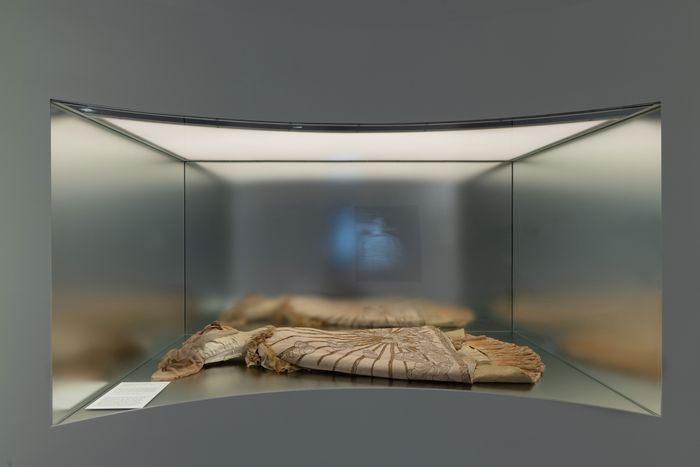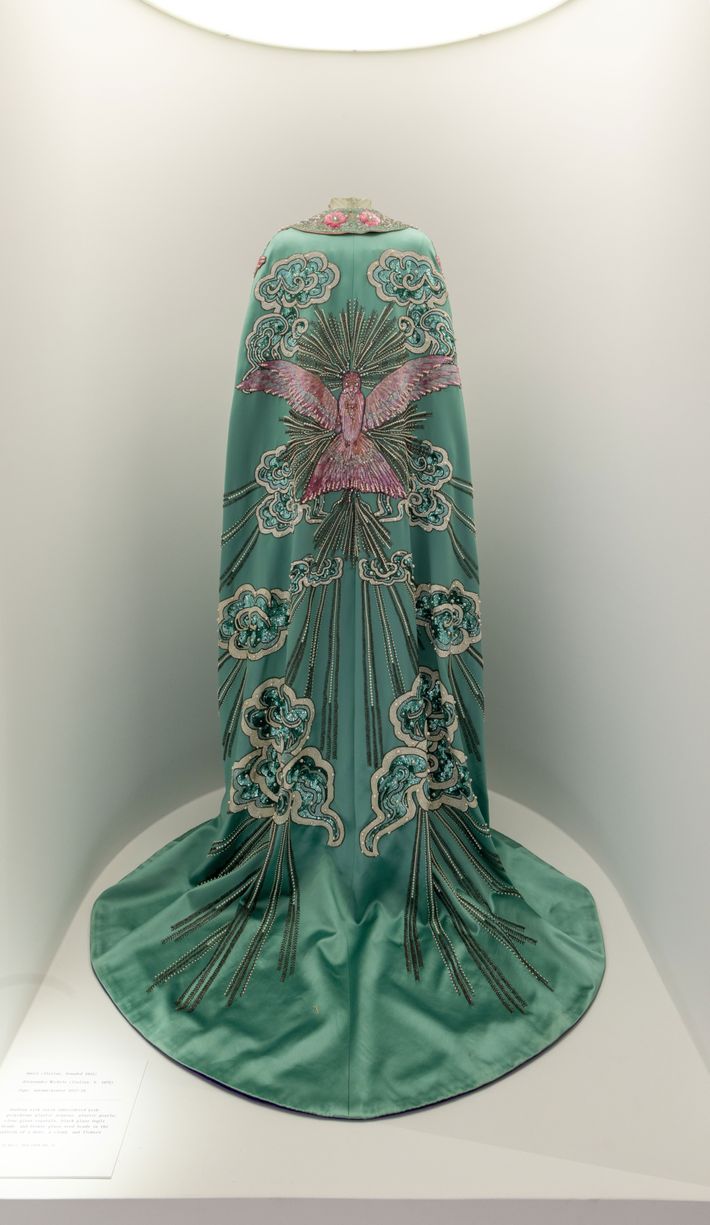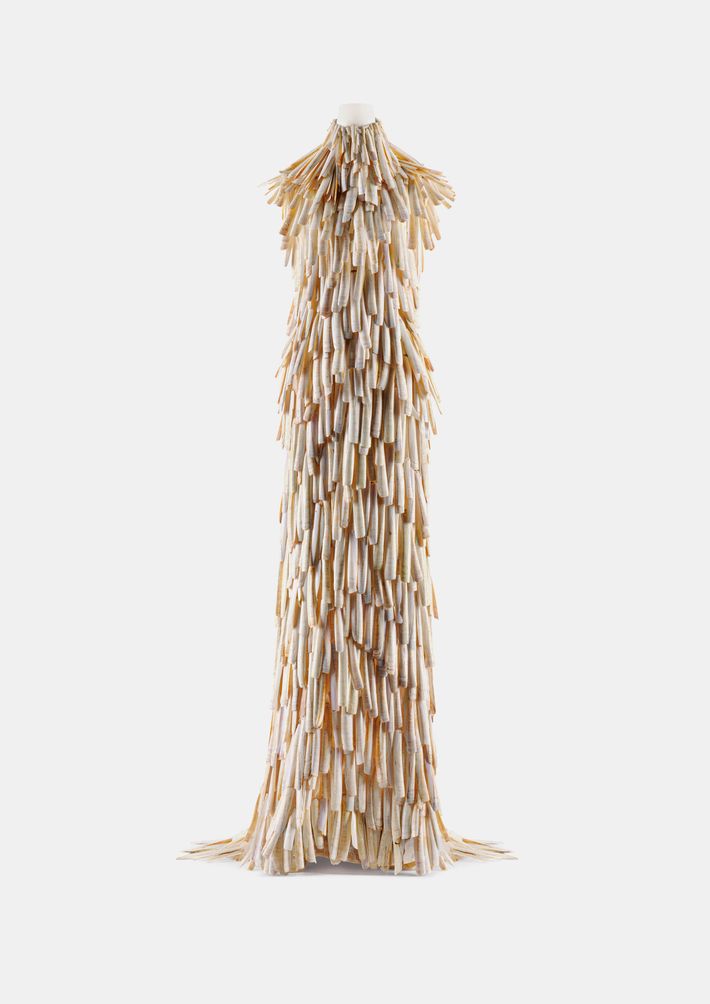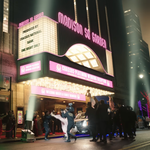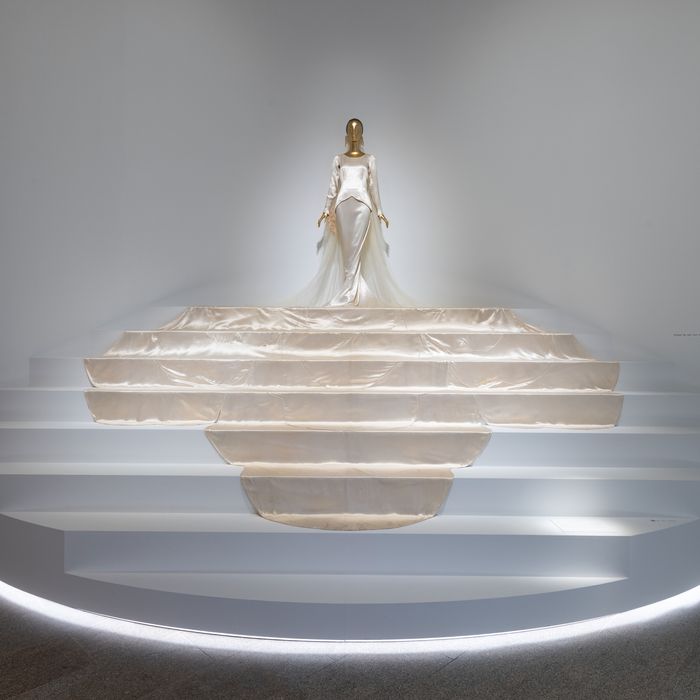
In an effort to express themselves — “be iconic,” in the immortal words of Cardi B — female celebrities have given rise to a new kind of red-carpet team player: the guys who help with their dresses so the women can actually walk. At the Met Gala on Monday, Cardi B had about eight men lifting the hem of her massive tulle gown while she gingerly climbed the steps. Gigi Hadid, though a pro at walking, had help too, and Kim Kardashian looked so constricted in her silver Galliano frock that I half wondered if the guys wouldn’t flip her sideways and just carry the queen into the museum like a log.
I don’t know if any of these women made it as far as the exhibition, entitled “Sleeping Beauties: Reawakening Fashion.” In any case, the contrast between the absurdity on the front steps of the Met and what its chief costume curator, Andrew Bolton, and his team of conservators and collaborators endeavored to do is striking. “Sleeping Beauties” is, quite possibly, the most nerdish and earnest costume show ever staged by a major museum. Not only does it address the problems of preserving old clothes, a pretty dry subject, but it attempts to move exhibitions beyond a purely visual experience. The show allows visitors to use all the senses — smell, hearing, even touch — with a little help from new technologies like AI and molecular recordings of smells on decades-old garments and accessories.
The first object that people will see in “Sleeping Beauties” is a pale green silk-satin ball dress by Charles Frederick Worth, the British-born dressmaker who in the mid-19th century invented the idea of a designer as an all-powerful force. Worth made the gown in about 1887 for the New York socialite Carrie Astor, a name many will know from HBO’s The Gilded Age; it has been in the museum’s collection since 1949. The dress, trimmed with tulle ruffles and embroidered with gold sequins and glass beads, is deteriorating, as clothing does. Even the colors of the ruffles have faded to different hues since the gown was previously cataloged. Nothing can halt the process, even the best skills of conservators. That’s why the dress is recumbent in a glass case under special lighting.
Nonetheless, you can hear the rustling sound such a creation made when it originally entered a room, a sound known as scroop — a blend of the words scrape and whoop. A scientific recording of scroop plays in the space. And you can see Carrie’s dress moving thanks to a hologram displayed on a screen on the opposite wall. Since the dress is now whirling about on an avatar, as if waltzing in Mrs. Astor’s famous ballroom, you can see its silhouette and that it has a bustle — something you can’t tell from the actual dress resting in the case.
“That was the most complex thing we did,” Bolton said of the hologram. He enlisted the expertise of the photographer Nick Knight, who has been using motion capture, 3-D scanning, and other technology for years to change how fashion is presented, and who served as creative consultant for the exhibit. (Knight worked with Alexander McQueen on the first live-streamed runway show, “Plato’s Atlantis,” in 2009.) The whole process of creating the hologram — analyzing the construction of the ballgown, making a new pattern, scanning it, getting the right materiality and proportions in the images, inventing the avatar, and applying the waltzing movements of a professional dancer — took seven months and 14 different simulations.
Since the process is so time-consuming, only one other garment in the show could be virtually animated — a hobble skirt from the turn of the last century. Still, visitors can see how women in these historical styles moved, and not just look at objects in a case or on a mannequin. And, as Bolton said, “You can extend the life of something through technology.” The actual dress will deteriorate — indeed, the Worth gown will probably never be seen again in public after this exhibit because of its fragility. Yet the hologram will exist forever.
I saw the exhibit on Tuesday during a preview for museum members. (It opens on Friday.) Although I knew a little about the sound recordings from reading the hefty catalog, I was baffled by the noise I heard. To me, scroop sounded like someone taking apart your washing machine or, at best, very mechanical white noise. I wondered how many of my fellow visitors knew what the strange sound implied as they entered the first room, which also contained several gowns from the 18th and 19th centuries, as well as an extravagant green silk cape from Gucci by Alessandro Michele and a digitally printed floral dress, from 2018, by Mary Katrantzou.
In fact, what we were hearing was scroop in its purest form. As the technical portion of the catalogue explains, illustrated by spectrograms, garments were analyzed in an anechoic chamber by Dr. Junpeng Lai and Dr. Ronald Miles of the State University of New York at Binghamton, an underground facility that minimizes ambient noise. As Lai and Miles wrote, “We never anticipated that the chamber would be used to record the sound of fashion.” Among the items the scientists recorded were a recent Marni dress embellished with tin flowers and McQueen’s famous razor-clam shell gown from the 2000 “Voss” show. The sound of the clam dress was pretty much off the charts.
But how useful is such information, really? It seems a bit of a sensorial gimmick in an age when they abound. Besides, it’s easy to imagine that a bunch of shells embroidered on a dress would make a racket. To me, it would have been far more interesting to record the rustle of feminine fashion in the 1850s, when multiple petticoats were the rage. That sound might illuminate how it felt to wear so many layers. Still, perhaps the best way to view the recordings that play in four rooms of the exhibit is the opening of a door to further sound experiments with clothes, as a way of thinking outside the curatorial box.
As a kind of sub-theme to the idea of “awakening” historical garments by reactivating their sensory qualities, Bolton explored nature — that is, flowers (specifically roses, tulips, poppies, and daisies); birds, bugs, and butterflies; snakes; marine life; and the mermaid, including the Mermaid Bride. That’s a reference to the show’s dazzling closer: Natalie Potter’s 1930 two-piece wedding gown by the Paris house Callot Soeurs, in a blend of silk satin and cellulose acetate, a man-made fiber that became popular in the 1920s. The slim, unembellished body of the dress looks boyish and amazingly modern, and the scalloped cathedral train suggests waves or a mermaid’s fin. The nature theme explains why so many guests for the Met Gala, and their stylists, chose looks adorned with flowers or evoking the earth, like Tyla’s molded, sand-colored Balmain gown. But I bet old Natalie didn’t need anyone to lift her up the steps at St. Bartholomew’s on her wedding day.
Of course, nature is also a good metaphor for the constant changes in fashion, which the exhibit demonstrates. As Knight writes in the catalogue, “All this exuberant dandyism, flamboyance and presentation of the self are not reserved just for the human world.” Among my favorite pieces in the show were French buttons from about 1770 that incorporated real insects, seaweed, and bits of feather; as the catalogue noted, they’re “tiny terrariums of natural curiosity.” It was the Enlightenment. People were eager to know, and to flaunt it.
And I loved Simon Costin’s extraordinary “Momento Mori” necklace, from 1986, made from the talons of a turkey and the skulls of three rabbits and linked together by a dickie of black beadwork. I’ve only ever seen photos of the necklace, which normally resides at the Costume Institute in a tank of argon gas, because oxygen causes mold. The piece is so wonderfully brutal and primitive, rather like fashion.
I had just passed through a room devoted to the hats, belts, and garments of the oil heiress and champion clotheshorse Millicent Rogers when I ran into Sissel Tolaas, the scientist who collected the smell molecules and designed the battery-powered system of tubes and glass beakers in a number of rooms that allows visitors to get a whiff of objects and times past. It’s surprising how much information is contained, for example, in Rogers’s hats. One chapeau, from Schiaparelli in 1939, trimmed with synthetic acorns, berries, and fruits, had peak notes of latex paints and enamels; resin; and, according to the wall text, “hexadecyl: found in unwashed human hair.” The wall texts throughout the exhibit are worth reading.
As with scroop, I’m not sure visitors initially understood what they were supposed to glean from the scents, or how it worked. “It smells like mothballs to me,” one woman said. A wall text in an early room led to misdirection. It read: “To release the smell, rub the wall gently.” I did as directed — until another visitor told me I was supposed to rub the wall to the left of the text. She had made the same mistake.
Still, as you proceed through the exhibit, the point becomes clearer and the smells are more interesting and potent. I sensed that people were really engaged, perhaps because they were doing more than just looking. As Tolaas said, “We have no words anymore because we see the pictures. You know? We don’t care. We are unhappy. We are frustrated. We are in limbo. What the senses do is make you engage in a different way.” Tolaas, who is working on a long-term study of the ruins at Pompeii, added, referring to the exhibit, “This is a laboratory situation. We are doing an experiment. And we are making protocols for the future.”
Bolton has been lately criticized for not producing enough exciting or blockbuster shows, like the 2011 McQueen exhibit, and for perhaps being too close to Anna Wintour. There have been rumors on top of even juicier rumors that John Galliano, following his viral fashion show in January for Maison Margiela, might be headed back to a job at LVMH. In 2011, the designer was convicted by a French court of making racist and antisemitic insults against patrons in a bar. He was also fired from Dior. He attended the gala the other night. Among the rumors is that a retrospective of his work was supposed to happen this year, in lieu of “Sleeping Beauties,” but board members and others at the Met objected. The possibility of a Galliano show has certainly been discussed. (Bolton declined to comment when I saw him.)
Be that as it may, “Sleeping Beauties” is plenty original. It presents a roadmap for what can be attempted in the future, especially regarding visitor engagement. I learned a lot from the show, nerdy or not. And one should be reminded that blockbusters are not planned; they just happen. That’s what Bolton himself realized in 2011. As he wrote a few years later, in the catalogue for the London exhibit of McQueen, “Critics often describe the exhibition as a ‘blockbuster,’ a term I find misleading as it seems to imply some sort of Machiavellian intentionality on the part of the Museum. In truth, the show’s success came as a complete surprise to everyone.”
Perhaps the novelty of “Sleeping Beauties,” with its smells and scroops — not to mention the diverse thrills of beholding a frail Worth and a dead-rabbit necklace — will produce a similar result.



